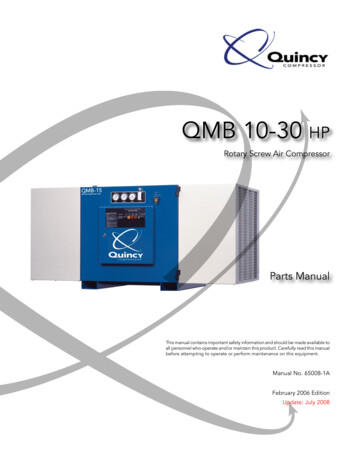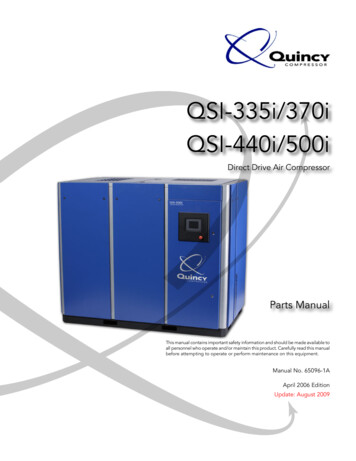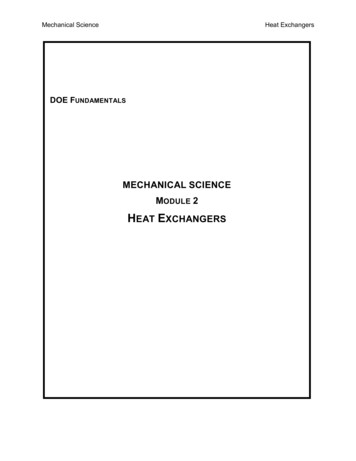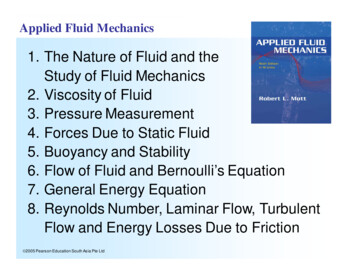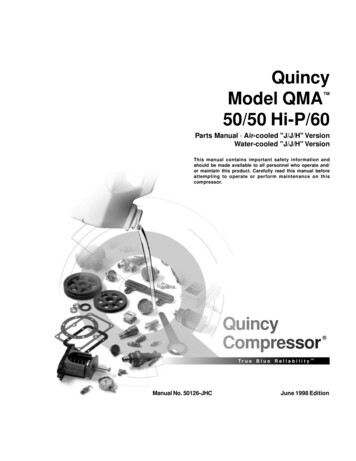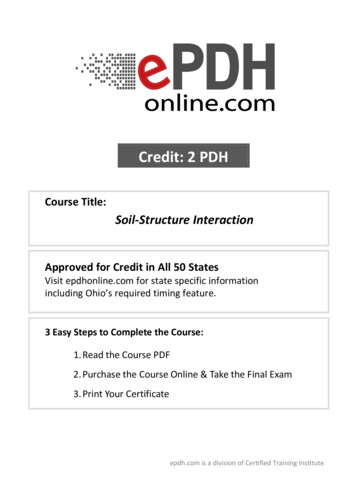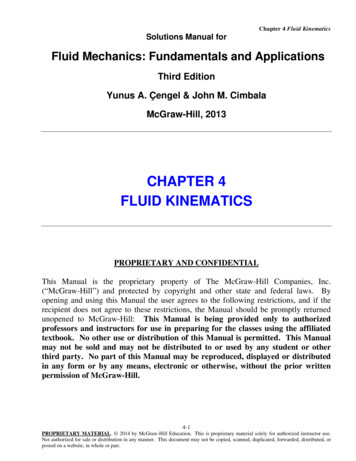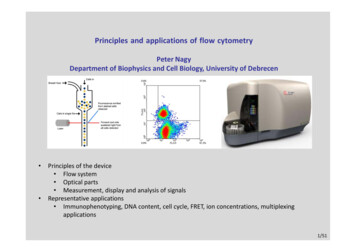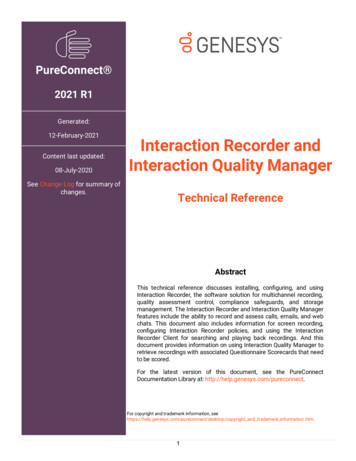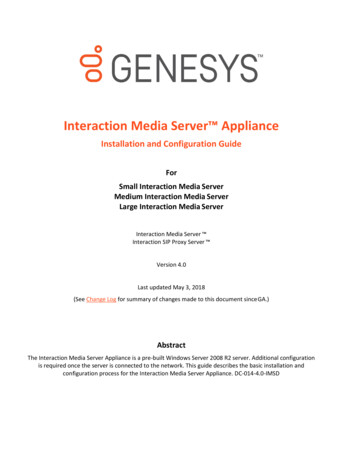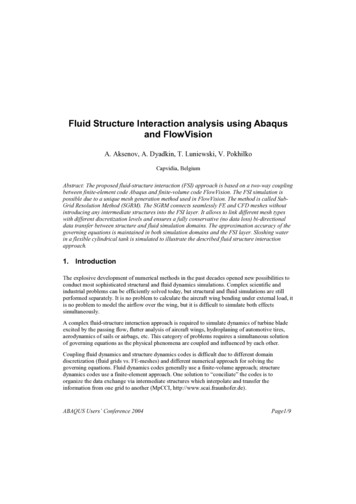
Transcription
Fluid Structure Interaction analysis using Abaqusand FlowVisionA. Aksenov, A. Dyadkin, T. Luniewski, V. PokhilkoCapvidia, BelgiumAbstract: The proposed fluid-structure interaction (FSI) approach is based on a two-way couplingbetween finite-element code Abaqus and finite-volume code FlowVision. The FSI simulation ispossible due to a unique mesh generation method used in FlowVision. The method is called SubGrid Resolution Method (SGRM). The SGRM connects seamlessly FE and CFD meshes withoutintroducing any intermediate structures into the FSI layer. It allows to link different mesh typeswith different discretization levels and ensures a fully conservative (no data loss) bi-directionaldata transfer between structure and fluid simulation domains. The approximation accuracy of thegoverning equations is maintained in both simulation domains and the FSI layer. Sloshing waterin a flexible cylindrical tank is simulated to illustrate the described fluid structure interactionapproach.1. IntroductionThe explosive development of numerical methods in the past decades opened new possibilities toconduct most sophisticated structural and fluid dynamics simulations. Complex scientific andindustrial problems can be efficiently solved today, but structural and fluid simulations are stillperformed separately. It is no problem to calculate the aircraft wing bending under external load, itis no problem to model the airflow over the wing, but it is difficult to simulate both effectssimultaneously.A complex fluid-structure interaction approach is required to simulate dynamics of turbine bladeexcited by the passing flow, flutter analysis of aircraft wings, hydroplaning of automotive tires,aerodynamics of sails or airbags, etc. This category of problems requires a simultaneous solutionof governing equations as the physical phenomena are coupled and influenced by each other.Coupling fluid dynamics and structure dynamics codes is difficult due to different domaindiscretization (fluid grids vs. FE-meshes) and different numerical approach for solving thegoverning equations. Fluid dynamics codes generally use a finite-volume approach; structuredynamics codes use a finite-element approach. One solution to “conciliate” the codes is toorganize the data exchange via intermediate structures which interpolate and transfer theinformation from one grid to another (MpCCI, http://www.scai.fraunhofer.de).ABAQUS Users’ Conference 2004Page1/9
In this paper another approach to solve fluid structure interaction problems is presented. Thisapproach is based on the Sub-Grid Resolution method (Aksenov et al, 1996, Aksenov et al, 1998).In this method the Cartesian grid with local adaptation is introduced in the fluid flowcomputational domain. The structure is described by a finite-element mesh. The external surfaceof the finite-element mesh is used as a boundary for the fluid flow. The cells in the fluid domainare intersected by the surface mesh describing the structure. The resulting cells are not simplifiedand stored in the form of complex polyhedrons. The cell sides that are part of the surface meshhave links to the original faces of the finite-element mesh. Solving fluid dynamics equations onsuch a grid provides a natural data transfer mechanism allowing transfer of data from fluid tostructure computational domains without any intermediate interpolation.The above described approach was tested using ABAQUS for the structural dynamic simulationand FlowVision for fluid dynamic simulation. FlowVision uses the finite-volume approach and theSub-Grid Geometry Resolution Method to solve the governing fluid dynamics equations.The numerical approach for solving fluid structure interaction problems using the Sub-GridGeometry Resolution Method is described in this paper. To demonstrate a fluid-structureinteraction problem, the simulation of sloshing water in a flexible tank is chosen.2. Sub-Grid Geometry Resolution Method for fluid domainA rectangular calculation grid is introduced in the fluid computational domain. To capture smallgeometry details and solution variations a local automatic grid adoption is used. The local gridadoption subdivides the initial cell into 8 different cells (1st level grid adoption).Structure FEmeshj-th elementElmFluid gridFijm-th cellFigure 1. Cutting finite-volume cell with finite-element mesh.ABAQUS Users’ Conference 2004Page2/9
The computational domain boundary is presented by a set of plane facets (surface mesh). Thissurface mesh is formed by a set of external faces Fij of the finite-element mesh (Figure 1), where iis the face number of element j. If a boundary crosses the grid cell the initial cell is cut by thesurface mesh transforming the original cell into a multifaceted polyhedron. A shape Sm of the m-thcell can be presented as a sum of cell faces Elm (here l is number of face) and part of the j-thelement i-th face dFijm that was cut by the cell itself(1)Sm l 1, LElm i 1, IdFijm ,where L is the number of existing cell faces and I is the number of faces. All this information is“stored” in the cell. The boundary cell “knows” the corresponding face dFij in the finite elementmesh. Using this link data can be easily transmitted to the FE code and back. For example, thepressure of fluid Pij on face Fij is found by integrating pressure over all cells containing this face:(2)Pij 1Pm s (dFijm ) ,s ( Fij ) m 1, Mwhere s(F) is the area of face F. The information from the finite-element code, for example,velocity of face Fij , is easily transmitted to the CFD code.3. FSI Numerical Method3.1Governing equationsThe dynamic equilibrium (for the discrete model in finite-element system) is defined in terms ofthe external applied forces (P), the internal element forces (I), and the nodal accelerations:(3)Md 2u P Idt 2where M is the mass matrix of the finite element system, u – displacement of the nodes. P is thesum of forces that act on the structure, including forces from the fluid.Navier-Stokes equations are used for the description of the fluid flow (in this paper theincompressible fluid is considered).(4)(5)V (VtV) P 1(µ V) gV 0where V is the velocity vector, P is pressure, µ - effective viscosity (turbulent and molecular), –density, g – gravity vector. The effective viscosity is calculated using a k- turbulent model (theABAQUS Users’ Conference 2004Page3/9
turbulence model does not affect the fluid-structure interaction and is not further discussed in thispaper)t.3.2Boundary conditions on fluid-structure interfaceExcept ordinary boundary conditions for simulating structure deformations, boundary conditionsat fluid-structure interface are specified in terms of pressure loading from the fluid calculated in(2) for each element face that is in contact with the fluid.The general boundary conditions are applied to inlet, outlet and walls and special boundaryconditions are specified on the fluid-structure interface:(6)Vij n 1, Nwnijdu nijdtwhere N is the number of nodes for element face Fij , wnij is weight coefficient for calculating facevelocity depending on the face geometry.3.3Numerical schemeLet’s assume we have a numerical solution for the displacement of structure nodes and velocitiesof the fluid at time step n at time moment t tn. To find the solution for the system of equations (35) at time step n 1 (tn 1 tn t) FlowVision uses split algorithms solving Navier-Stokes equations(Belotserkovsky, 1994) based on an accurate approximation scheme for convective impulsetransport (Aksenov et al, 1993). Navier-Stokes equations for cells with volumes changing in timehave the following notation:(7)(8)V n 1VntV n 1 ( V n 1V ) V n 1v n 1 v nv n 1P n 1 1( µ V n 1 ) gv n 1 v nv n 1here vn and vn 1 are the cell volume at time step tn and tn 1(Figure 2).ABAQUS Users’ Conference 2004Page4/9
Structure FEmeshvnvn 1Fluid FVgridnFigure 2. Changing volume of fluid cell from v to vn 1in time step.The first term in the right part of equation (7) is the reaction force from the structure on the fluid.The term in the right side of equation (8) describes the changing mass inside the cell. If the cellv n 1 v nequals zero and (7-8) corresponds to thedoesn’t contain a moving boundary, the termv n 1approximation of ordinary Navier-Stokes equations.An explicit method is used for solving structure dynamics equations.(9)d 2udt 2(10)dudt(11)un M 1 (P I)n 1 / 2n 1 udu dtn 1n 1/ 2 tn 1n( t n 1 t n ) d 2 u 2dt 2dudtnn 1 / 2FlowVision supplies the numerical solution for system (7,8), ABAQUS solves the system (9-11).3.4Selection of the time step tThe time step t is selected as minimum time steps of a stable solution in Abaqus and FlowVision.The maximum time step is selected in Abaqus and equals(12)t structure Lmin,cdABAQUS Users’ Conference 2004Page5/9
where Lmin is the smallest element dimension in the FEA mesh and cd is the dilatational wavespeed.cd where 2µand µ are Lame constants for structure material.The maximum time step for fluid modeling is selected in FlowVision and equalst fluid min((13)hmk)Vmkfluid structure int erfacewhere hmk distance between m-th and k-th cells and Vmk is velocity of the fluid between those cells.Cells m and k are cells that lie near the fluid-structure interface.One can see that both time steps are responsible for transferring the disturbance between thenodes. The time step for integration of the system (7-11) can be selected as minimum betweentstructure and tfluid to get a stable solution(14)t min( tstructure, tfluid)On another hand, the solution of the system (7-11) can lead to quite different time steps for the“structure” part and the “fluid” part. The “limiting” system is the system requiring the solutionwith the smallest time step. To avoid solving the system of equation with very small time step, thetime step is chosen as maximum ( tstructure, tfluid). In this case to satisfy the stability conditions,the “limiting” system is solved iteratively with smaller time increments. During these iterations,inside the time step, boundary conditions transferred from the “non-limiting” system stay constantuntil the end of each time step.3.5ImplementationLink with ABAQUS is made using the user DLOAD function (VDLOAD for ABAQUS explicit)for transfer of loads calculated in FlowVision. Node positions are obtained by FlowVision viaODB utilities.The following algorithm for calculating n-th time step is used:1.Preliminary increment dT of n-th time step is calculated.tn tn-1 dT2.ABAQUS calls DLOAD, pressure from n-1 time step transferred from FlowVision.3.ABAQUS specifies its own stable time increment dt4.ABAQUS makes increment, current time ABAQUS time t’ increased by dtABAQUS Users’ Conference 2004Page6/9
5.ABAQUS writes data to ODB file.6.FlowVision seek last write in ODB file to get ABAQUS time t’.7.if t’ tn, go to 28.FlowVision reads ODB file to get node positions on n-th time step and value of n-th timestep tn.9.FlowVision makes simulations with time increment tn-tn-110. if it is not end of simulation, go to 14. Simulating sloshing water in a flexible tankThe described simulation approach of the fluid structure interaction problem is performed forcalculating water motion inside a flexible tank (Figure 3, a). The bottom of the tank is oscillatingwith speed 0.2sin(1.8 t) m/sec, where t is time in sec. The walls of the tank have the followingproperties – density 3.000 kg/m2, Young modulus 9x105 N/m2, Poisson coefficient 0.3.Dimensions of the tank and finite element mesh (Figure 3, a). The tank is filled with water withheight 2 meter (Figure 3, b)a)b)Figure 3. Flexible tank. a) finite-element mesh and dimension, b) initial water stateThe problem is solved using ABAQUS-Explicit v6.4 and FlowVision 2003 solving Navier-Stokesequations for incompressible fluid with k- turbulence model. The water-air interface is tracked byVOF (Volume of Fluid) -like method (Hirt , Nichols, 1981).ABAQUS Users’ Conference 2004Page7/9
The number of cells in the finite-volume grid is 16.000, the finite-element (tank) mesh includes5.100 nodes and 3.300 elements. The time step is 0.03 sec.Figure 4. Pressure (Pa) and water surface distribution at time 3 sec.The water pressure distribution is shown in Figure 4 by color map, time moment is 3 sec. Thewater surface is shown by contour. The computational domain is cut by plane to visualize detailsinside the tank.5. ConclusionAn efficient realization of the fluid-structure interaction is possible due to the unique Sub-GridResolution Method providing natural link between CFD and FEM meshes. The simulation ofsloshing water in a flexible tank with oscillating bottom is just one example. The describedapproach has been successfully used for other simulations involving complex geometry, multiphase media, moving bodies and large structural deformations.Known limitation of the approach: the fluid boundary is defined by the FEM mesh, which in somecases is not accurate enough to describe the boundary for the fluid flow calculation. An illustrativeexample is bending of a turbine blade caused by the passing gas flow. To describe accurately theflow separation on the blade surface the fluid grid has to be very fine. Thus, the finite elementmesh must also be very fine. This is not practical as the resulting FEM models become huge andunmanageable. To overcome it we will use the original CAD geometry. The Sub-Grid ResolutionMethod constructs the fluid grid by intersecting the orthogonal fluid cells with the CAD surfaceexactly describing the fluid-structure border. The elements on the fluid-structure border can nowbe matched with the much coarser FEM mesh. This is ultimately solving all limitations of thedescribed above fluid-structure interaction approach and will be implemented in the nextFlowVision release.ABAQUS Users’ Conference 2004Page8/9
6. References1. Aksenov A, Dyadkin A, Pokhilko V. Overcoming of Barrier between CAD and CFD byModified Finite Volume Method, Proc. 1998 ASME Pressure Vessels and Piping DivisionConference, San Diego, ASME PVP-Vol. 377-1., 19982. Aksenov A., Dyadkin A., Gudzovsky A., 1996, “Numerical Simulation of Car TireAquaplaning”. Computational Fluid Dynamics ’96, J.-A. Desideri, C.Hirsch, P.Le Tallec,M.Pandolfi, J.Periaux edts, John Wiley&Sons, pp. 815-820.3. Aksenov A., Gudzovsky A., Serebrov A., 1993, “Electrohydrodynamic Instability of Fluid Jetin Microgravity”, 19-24, in Proc. of 5th Int. Symposium on Computational Fluid Dynamics(ISCFD), Aug. 31 - Sept. 3, 1993, Sendai, Japan, Japan Society of Computational FluidDynamics, Vol.1, 1993.4. Belotserkovsky, 1994 Numerical Methods in Continuum Mechanics, Moscow, Fizmatlit, 2ndedition, p.441.5. Hirt C., Nichols B. 1981, “Volume of Fluid (VOF) method for the dynamics of freeboundaries”, J.Comput. Phys. v. 39, pp 201-225.ABAQUS Users’ Conference 2004Page9/9
between finite-element code Abaqus and finite-volume code FlowVision. The FSI simulation is possible due to a unique mesh generation method used in FlowVision. The method is called Sub-Grid Resolution Method (SGRM). The SGRM connects seamlessly FE and CFD meshes without introducing any intermediate structures into the FSI layer.
